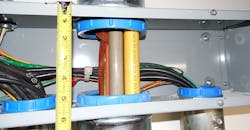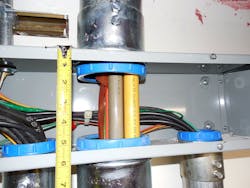Illustrated Catastrophes: Wrong Way Wireway
All references are based on the 2017 edition of the NEC.
Wrong Way Wireway
Although you probably can’t see it, there’s a 4-in. stamp on the top EMT connector. The conductors inside the EMT are 600kcmil THWN. Obviously, the installer ignored both of these dimensions when choosing and installing this wireway.
There are a couple of options for sizing wireways. When insulated conductors are deflected in the wireway, or where raceways enter or leave the wireway, Sec. 376.23(A) requires dimensions based on Column 1 from Table 312.6(A). For the 600kcmil wires installed here, 8 in. would be needed between the conductor’s entry and the opposite wall. Where wireways are used as pull boxes, Sec. 376.23(B) requires dimensions corresponding to Sec. 314.28(A)(1) for straight pulls and Sec. 314.28(A)(2) for angle pulls. For this straight pull, a dimension of (8 in. × 4 in.) 32 in. would be required. This installer has only provided a 6-in. wireway.
You may need to have a discussion with your AHJ to determine what constitutes “using a wireway as a pull box” because there are no clear-cut guidelines provided in the Code, and it makes a huge difference. It appears this installer never had those discussions.
Loose Liquidtight Loser
Based on tight spaces involved with bending this liquidtight flexible metal conduit (LFMC) into position for connection to the box, perhaps the installer should have considered using a 90° connector instead of a straight connector to make the connection. The tension on the raceway has caused it to pull completely out of the connector. Thankfully, this did not short circuit the wiring, and it was an easy repair.
Section 350.24 requires bends in LFMC to be made so the conduit will not be damaged and the internal diameter of the raceway is not effectively reduced. Section 350.42 allows angled connectors to be used as long as the connectors are not concealed. That would have been a good choice for this installation. The loose raceway also defeats any equipment grounding and bonding that may have been required by Art. 250. Generally speaking, Sec. 350.30(A) requires ½-in. LFMC to be secured within 12 in. of this box, but Exception No. 2 allows other options. In this case, Item 1 of the Exception allows 3 ft between the box connector and the next raceway support. More supports may have helped prevent the raceway from separating in the first place.
Save
About the Author

Russ LeBlanc
Owner
Russ started in the electrical trade as an apprentice in 1985. He worked his way up to become a Journeyman Electrician and then eventually became a Master Electrician and Licensed Construction Supervisor. In 1999 Russ become an Electrical Instructor for The Peterson School of Engineering in Massachusetts where he developed his passion for teaching, and quickly became Department Head of Electrical Instruction. Russ has taught thousands of apprentices, electricians, engineers, inspectors, and other electrical professionals during his career as an instructor. He continues to provide electrical professionals with Electrical Code seminars, Arc-Flash Awareness training seminars and educational material through his LeBlanc Consulting Services in North Reading, MA whose specialty is educating electricians. He has been an active member of the NFPA Electrical Section and has authored hundreds of National Electrical Code proposals and comments which have become Code rules to improve the safety for the electrical industry. Russ is also an IAEI certified Electrical Inspector.
Please visit www.russleblanc.net for more information.


